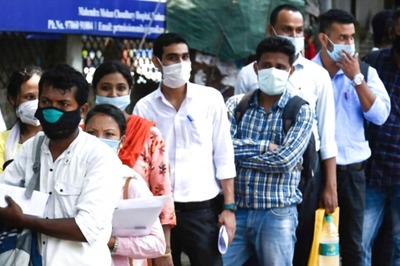
views
New Delhi: In November 2017, a four-year-old girl was allegedly harassed by two male teachers in G.D.Birla Centre for Education, Kolkata. The incident led to widespread protests. It was only after this incident that the school authorities considered the safety of students and installed CCTV cameras across the school campus.
The same school was in spotlight earlier as well for accusations of sexual abuse of one of its students. A child had fallen asleep in the school bus in presence of an “uncle”, but woke up to an “aunt” putting her dress on, according to a complaint filed by parents of the victim, The Telegraph had reported.
Parents feel that it was the uproar against the issue that the school took timely action and installed cameras in the school. “If parents wouldn’t have protested, nothing would have changed,” a parent said on condition of anonymity.
The G.D.Birla incident presents the tip of an ice berg. According to National Crime Record Bureau (NCRB) data, reported crimes against children were recorded at 88,108 in 2014, 92,715 in 2015 and 10,4705 in 2016, inidcating a steady increase. However, there is no separate data available for girl children.
A closer look at the educational institutions reveals several lacuna in the safety for girl students.
A recent Thomson Reuters survey ranked India as the world's most dangerous country for women, even worse than war-torn Afghanistan and Syria. The safety concerns affect not only grown-up women, but also young girls in schools.
Where It All Begins
A recent survey conducted by a child rights organization, Save the Children, on perception of girls safety in public spaces, suggests that over 90 per cent of the adolescent girls in both urban and rural India, felt the safest at home. Yet, individual cases present a contrary view.
“I have dealt with cases where the child doesn’t feel safe around their own fathers or brothers,” said Aruna Broota, a clinical psychologist, working closely with children.
Even disclosing their dilemma to the mothers does not help. They are encouraged to hush up the case and not to take it seriously.
According to the survey, one in three adolescent girls mentioned in the survey said they would rather confide in their close friends. Teachers, school staff, and local police do not feature significantly on the list of confidants for the girls. Parents, relatives, and friends are preferred as confidants than teachers.
What Schools Are Doing
Surveillance measures like CCTV cameras are a step towards safety of children.
“Teachers have to be more cautious now. We have regulations about how many students can go to the washroom together, having teachers and attendants in school buses, maintaining a roster with the number of students when a teacher leaves a classroom among other things,” said Dr. Onika Mehrotra, Director of Kalka Group of Schools.
Safety of students on campus did not receive the much importance till a few years ago. But as more cases of abuse are surfacing, the schools are waking up to the crises.
“Being vigilant at every step nowadays is a necessity. The teachers, the students, the parents and everyone around a child needs to be vigilant,” added Mehrotra.
According to school principals this reporter spoke to, the school buses are nowadays GPS enabled so that even parents can track them throughout the ride.
However, while certain urban schools boast of sound infrastructural facilities, the same is not the case all over the country.
The two other major things, whose absence makes girls at schools more vulnerable to ‘strangers’ are boundary walls and lack of toilets.
Only 64% of schools have boundary walls according to a report for 2015-2016 by the National University of Educational Planning and Administration. This allows strangers to have access into the school campus.
7% of girls feel that the school toilet is an unsafe space, whereas in small and medium town the rate is 10%, according to a report by Save The Children.
“We aren’t allowed to go to the washroom or the sick room alone. We have to be accompanied by another classmate, even if there is an attendant in the washroom,” said Orunika Ghosh, a student of class 11 from Modern High School for Girls, Kolkata.
Beyond Sexual or Physical Harassment
Serious cognizable offences aren’t the only concerns plaguing girls in schools. Bullying, peer pressure and backstabbing are common occurrences that go unnoticed but have far-reaching far psychological consequences.
“Being accepted in peer groups is a major part of lives of young girls,” said Nalini Deka, Professor of Psychology, Indraprastha College for Women.
From issues like inferiority complex to bullying, a number of psychological issues of girls go unattended in schools.
According to the National Mental Health Survey of India, 2015-2016, 7.3% Indian teenagers in the age group of 13-17 suffer from mental health issues. The numbers are nearly equal for boys as well as girls.
Adding to the problem, teachers are also not well equipped to deal with individual cases of seclusion, rejection and needs of special children.
“I don’t think any part of teacher training courses gives teachers an understanding of these issues. They are more prone to just telling off the students who are at fault,” said Nalini.
“Telling off and not understanding the deep-seated issues about why at all the situation arose and the possible consequences of it, only worsens things,” she added.
Trouble Doesn’t End At School
While schools try to do their best in making it a safe space for girls, the concerns don’t end here.
In a survey conducted by Save The Children, travelling in public transport gave the highest sense of risk perception across both urban (47 percent) and rural (40 percent) centres. Most respondents traveled by public transport for going and coming back from school. They said that they feared for the safety.
The parents also are indifferent to the troubles faced during commute.
“The parents care a great deal about academics and amenities in schools, but do not show much concern about the mode of conveyance their child uses. We tell them regularly to check the identity of the auto-rickshaw and bus drivers,” said Dr. Onika Mehrotra.
Another factor that determines the safety of children is the ‘pampering’ at home. Being in the constant company of a maid or someone at home inhibits them from taking even the smallest decisions by themselves, according to psychiatrists.
“Because of a lifestyle where the parents are mostly busy and try to pamper the kid as much as possible, the kids are not exposed to small dangers in their daily lives. These can be as simple as falling down and managing wounds by themselves. Due to this, they fail to develop a sense of street-smartness,” added Mehrotra.
Awareness for Students and Teachers in Schools
In most schools, the cases of sexual abuse and harassment arise out of initial exploratory behaviour and lack of awareness, according to psychiatrists. On one hand, students are exposed to a society where nobody talks about sex and on the other, they freely explore all of it on the internet, leading to a misinformed paradoxical situation.
The problem further multiplies because of “the increase in exposure to the media and the internet, children come across pornographic content, intimate scenes and sexual contexts very early on,” according to psychologists working with children of this age group.
“Schools do not provide sound information or awareness about bodily developments, sexual activity and consent, leading to unwarranted incidents,” said Aruna Broota.
Shireen Vakil, Head of Policy, Tata Trusts, which works closely with adolescent girls, points out other issues that need to be addressed.
“Schools were advised to create a conducive climate that is free from fear, anxiety, and stress so that children learn joyfully and learn to work together harmoniously,” she said.
But workshops and interactions with specialists and psychologists are not given the enough importance or time.
Aruna Broota, who conducts workshops in schools, said that there is an overall nonchalant attitude of the schools towards these workshops.
“The workshops are only done as an eyewash and on a superficial level. I am often asked to wrap up my sessions somehow in half an hour,” she said.
While students themselves are not equipped to deal with unwanted experiences, the teachers too are not sensitized to approach these matters.
“The teachers look here and there and are visibly uncomfortable when I conduct these workshops for students. The students are bursting with information and they have nobody to ask all the questions,” added Broota.
(The story is part of News18 series #BeingAWoman. This edition of the series focuses on the safety of women in both private and public spaces.)




















Comments
0 comment